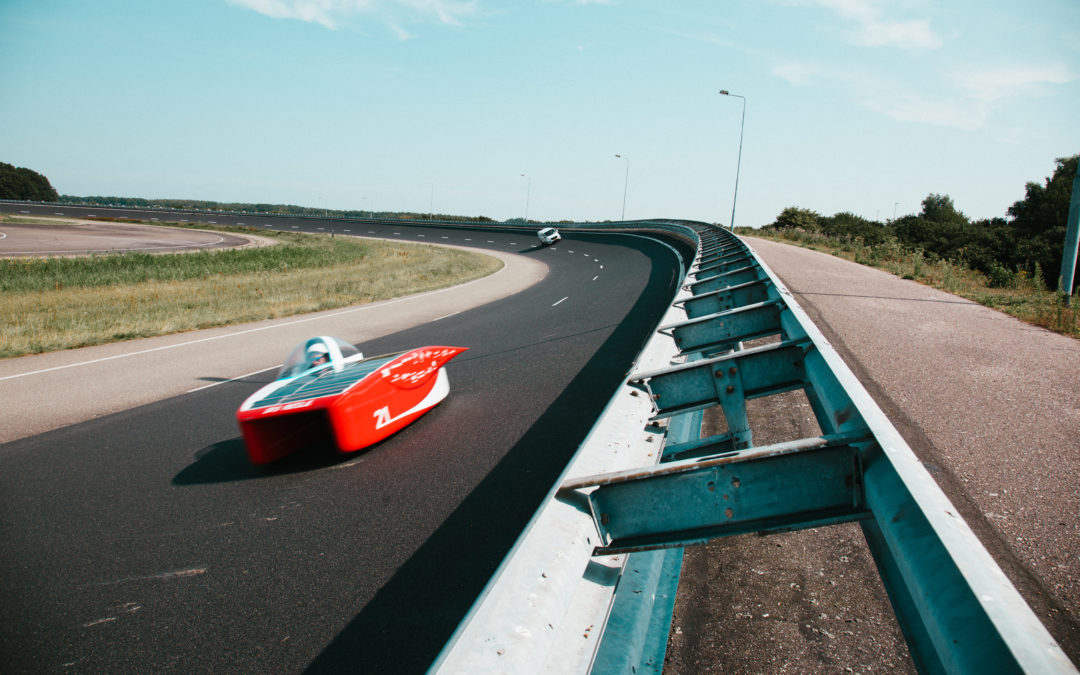Header photo by Martina Ketelaar
EN|NL
Our solar car RED E does not drive alone during the Bridgestone World Solar Challenge: a whole convoy drives along it with a total of 39 team members. In this blog series we will explain how we cross the Outback with the entire team and our solar car. This week we will tell you more about the center of the convoy: the solar car and its drivers.
To design, produce and test our smallest solar car ever, RED E, we have worked for months. RED E is the car it is all about! In the past few months we have already written a lot about the solar car and explained several technical components in our Wisdom Wednesdays. What is it like to sit inside of RED E during the race and what does it take to drive this small solar car?

The world of the driver
The driver will drive through the Outback alone for more than three hours. It will soon become quite hot in the solar car, sometimes over 40 degrees. The driver has almost no contact with the outside world, it has no radio (entertainment) in the car and only a small fan that functions as an air conditioner. The only things the driver has are the Stuart Highway and contact with the DMU. Therefore, it is important that our drivers are fit and focused during the race. In addition, the drivers need to be stress resistant: what will you do when a large road train (huge truck) overtakes you; when a kangaroo jumps in front of you or when you have to drive over a cattle grid? Indeed! Then it is important to stay calm and keep the car on the road.
Eyes and ears of the solar car
As mentioned before, the only contact the driver has is with the rear escort car, the DMU. The DMU will contact the drivers to see how it is going with them and with the solar car. Communication is done with a radio. Therefore, the driver must be strong in communication and be able to clearly state what the situation in the solar car is. In addition, as a driver you are the eyes and ears of the solar car. This is in particular valuable for our data acquisist, the person who keeps track of all data in and around the solar car and checks whether everything is running as expected. The data acquisist can only see the data, while the driver can also hear and feel what the solar car is doing.
Physical characteristics of a driver
Both the regulations from the Bridgestone World Solar Challenge as well as the dimensions of our solar car influence the physical characteristics of the drivers. The two most important requirements for the drivers are their height and weight. The team has decided to allow 1.80 meters as the maximum length. Therefore, the solar car was designed for this physical length. People who are longer than 1.80 meters will either not fit in RED E or not meet the safety requirements of the regulations. The weight is determined by the organisation and is set at 80 kilograms. Each driver will receive ballast to have a total weight of 80 kilograms. In this way, all the drivers of all the different solar teams have the same weight. A driver could be heavier than this, but extra weight also means a less efficient race. That is why we maintain the maximum weight of 80 kilograms within our team.

Picture by Martina Ketelaar
Practice makes perfect
In the past weeks, our drivers have been training a lot in the Australian heat. The four team members exercise almost daily to maintain their shape and they also drive a lot in the solar car to get used to the extreme temperatures. Getting in and out the solar car is practiced as well, to gain time during the race.
Do you have any questions for one of our drivers? Ask your question via our social media channels. This Thursday we will be interviewing one of our drivers, during our live vlog from Darwin!


Recent Comments